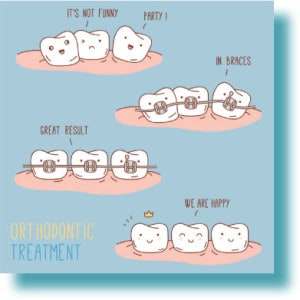
An orthodontist not only has the task of producing beautiful smiles, but occasionally he or she has to act as a counselor for parents who are concerned about their child’s teeth. It has not been uncommon to have a parent say to me, “Oh, I need to bring my child to you for you to look at him/her. The teeth are really a mess.” Such a statement braces me for the worst (no pun intended), but more often than not, when I clinically examine the patient, the malocclusion (a condition whereby a person’s teeth do not line up properly when coming together) is nowhere near as bad as originally presented. When I have told the parents this, I witness this collective sigh of relief – especially if I tell them no teeth need to be extracted or jaw surgery is not required.
Even though most orthodontic cases are seen as addressing esthetic concerns in order to produce beautiful smiles, I am most concerned about function – speech, chewing, swallowing – and I treat each case to ensure that the patient can function as naturally and normally as possible. Therefore, the orthodontist stands at the crossroads between esthetics and function, a place where one must also assess the patient’s (and parent’s) values. So who makes that call? Me? The patient? Mom or Dad?
My training involved assessing what an ideal finished orthodontic case looks like. We looked at how the upper teeth touch the lower teeth, how much of an overbite exists, how straight the teeth are, and how even the bite is. The American Board of Orthodontics (ABO) has criteria for a ideal orthodontic treatment outcomes, and board certified orthodontists are bound to approach each case with that ideal as the goal. There are orthodontic cases which may need to be compromised if the dental malocclusion is severe, but if all parties are aware of this from the initial examination, we are better prepared for just how treatment must proceed. So, for me, the ABO guidelines establish my values as to when an orthodontic case is finished. Some patients, though, may not see it the same way as I do – especially if a case’s treatment time is taking longer than expected.
While I am toiling away, repositioning brackets and bending wire, I have someone asking me, “How much longer until I get these off?” Based on my professional assessment of the case as it currently stands, the treatment is not yet complete, and so my values may say we are not finished yet. The parent and/or the patient may see it differently – the teeth look straight, they appear infinitely better than when we started, why not take them off? What they may not realize is that cosmetic appearance isn’t the only concern. In many orthodontic cases, creating a healthy bite, preventing possible tooth and/or bone loss and insuring proper functioning for a lifetime is a primary goal. When we can achieve both a healthy and beautiful smile, then we have hit the jackpot!
Ultimately, I must honor the final wishes of my patients, but I will do everything I can to educate them about both aesthetics and function. If the patient likes what he or she sees, then we have a positive orthodontic result, and that is a value we can all agree on.
Related posts
Newsletter Subscribe
Newest Posts
Set Up a Parental Control for Online Safety
Have you ever wondered how long your children spend in front of a device without your supervision? Yes, it is…
Adopt A Life, Save A Life
By Jeff Ashin, CEO, Young-Williams Animal Center. Photo by: Young-Williams Animal Center Are you or your child thinking of adding…

